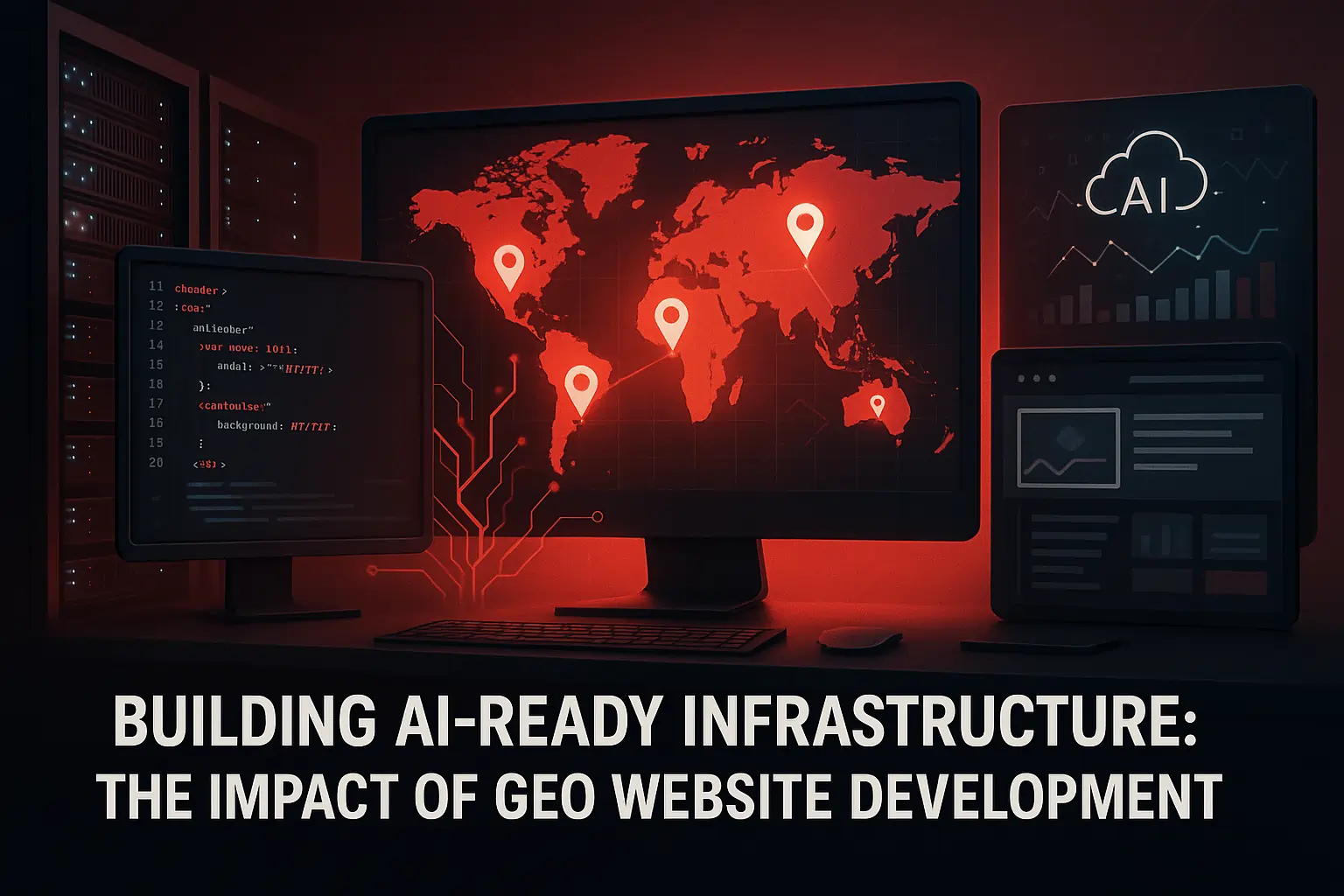Building AI-Ready Infrastructure: The Impact of GEO on Website Development

The digital world is in the middle of another massive shift. For years, business leaders and marketers in India have focused on a simple goal: ranking number one on Google. We overpowered Search Engine Optimization (SEO), learning the language of keywords, backlinks, and domain authority. But the ground is moving beneath our feet. Search is no longer just a list of blue links. It's becoming a conversation.
With the promotion of powerful AI tools like Google's AI Overviews, ChatGPT, and Gemini, users are no longer searching; they are requesting. They expect direct, comprehensive answers, not a list of websites to sift through. This fundamental change demands more than just a new content strategy; it requires a complete rethinking of the technical foundation of your website.
Welcome to the era of Generative Engine Optimization (GEO). This is the next frontier of digital visibility, and it’s created not just on what your website says, but on how it is structured. For your brand to be the source of truth for these new AI engines, your website's infrastructure must be intelligent, machine-readable, and built for trust. This article will show you through the technical pillars of building an AI-ready website, ensuring your brand is not just a participant but a director in this new AI-driven era.
What is Generative Engine Optimization (GEO) and Why Does it Demand a New Approach to Web Development?
Generative Engine Optimization (GEO) is the practice of structuring and optimizing your digital presence to be the preferred source for AI-powered answer engines. The goal is no longer just to rank in a search result; it's to be cited, referenced, and featured directly within the AI-generated answer.
This marks a critical evolution from traditional SEO:
- From Clicks to Citations: SEO focuses on winning clicks from a list of results. GEO focuses on becoming a trusted source that an AI engine quotes directly.
- From Keywords to Context: While keywords are still relevant, GEO prioritizes deep contextual understanding. AI engines need to understand not just what a page is about, but how it relates to a broader topic and why it should be trusted.
- From Ranking Pages to Building Authority: GEO is a holistic approach. It’s about demonstrating such deep expertise and authority that AI models see your brand as a definitive and reliable source of information.
This shift has profound importance for web development. An AI-ready website cannot be an afterthought. The technical architecture from site structure to content delivery systems must be intentionally designed to communicate clearly and effectively with AI crawlers. Your website's very foundation needs to be rebuilt to "speak AI."
The Three Pillars of an AI-Ready Website Infrastructure
To build a website that thrives in the age of AI, developers and business leaders must focus on three core technological pillars. These pillars work together to create a digital presence that is not only user-friendly but also machine-intelligent.
Pillar 1: Building Your Digital Library with Semantic Site Architecture
Think of your website as a library. In a poorly organized library, books are scattered randomly, making it impossible for a librarian to find a reliable answer to a complex question. A well-organized library, however, groups books by subject, with clear sections and labels. This is the principle behind a semantic site architecture.
For AI, your website's structure is a direct signal of your expertise. By organizing your content into logical "topic clusters," you demonstrate a comprehensive understanding of your field.
Technical Implementation:
- Pillar and Cluster Model: This is the gold standard for AI-ready architecture. Create broad "pillar pages" that cover a core topic comprehensively. Then, create multiple "cluster pages" that delve into typical sub-topics, all linking back to the main pillar page. For example, a digital marketing agency might have a pillar page on "Digital Marketing," which links out to cluster pages on "SEO Services," "Social Media Campaigns," and "PPC Advertising."
- Strategic Internal Linking: Use descriptive internal links to connect your pillar and cluster pages. This creates a logical hierarchy that helps AI crawlers understand the relationships between your content, establishing your site as a deep subject-matter authority.
Pillar 2: Speaking the Language of AI with Advanced Schema Markup
If site architecture is the library's layout, schema markup is the detailed label on every single book. Schema markup is a form of structured data that acts as a translator between your website and AI systems. It explicitly tells search engines what your content
means, removing all guesswork.
For an AI engine, a page with proper schema is a verified source of facts. It can confidently extract information like product prices, business hours, or answers to frequently asked questions because the schema provides a machine-readable guarantee of what that information represents.
Technical Implementation:
- Use JSON-LD: This is the recommended format for implementing schema, as it is preferred by search engines and is easier to manage without altering the HTML content of your site.
- Implement Key Schema
Types: Go beyond basic schema. To be truly AI-ready, your site
should leverage a range of specific schema types, including:
- Organization Schema: Establishes your brand's identity, contact details, and official profiles.
- Product Schema: Details price, availability, and customer ratings for e-commerce sites.
- FAQ Schema: Marks up question-and-answer sections so AI can pull direct answers.
- Article & Author Schema: Connects your content to credible authors, boosting trust signals.
- Speakable Schema: Highlights sections of content that are ideal for being read aloud by voice assistants.
- Validate Rigorously: Use tools like Google's Rich Results Test to provide your schema is implemented correctly. Errors in your structured data can make it useless to AI crawlers.
In the GEO era, schema markup is no longer an advanced "nice-to-have"; it is a foundational requirement for digital visibility.
Pillar 3: Future-Proofing Your Content with a Headless CMS
Traditional content management systems (CMS) were built for one purpose: to display content on a website. This model is no longer sufficient. Your content now needs to be ready for websites, mobile apps, voice assistants, in-car displays, and countless AI interfaces that don't even exist yet.
A Headless CMS decouples your content (the "body") from its presentation layer (the "head"). Your content is stored in a central repository and delivered via APIs to any front-end application. This API-first approach is the key to making your content truly AI-ready. It ensures your knowledge is structured, reusable, and instantly available to any platform that needs it.
Technical Benefits:
- Omnichannel Readiness: Create content once and deploy it everywhere, ensuring brand consistency across all touchpoints.
- Enhanced Performance: Decoupled architectures are generally faster and more scalable, which are positive signals for both users and AI crawlers.
- Increased Security: Separating the content management environment from the public-facing display reduces potential attack surfaces.
- AI-Powered Automation: Modern headless platforms are increasingly integrating AI to automate tasks like metadata tagging, content personalization, and workflow optimization, further streamlining your AI-readiness.
Designing Content for Machine Readability: On-Page Best Practices
A robust technical infrastructure is the foundation, but the way you structure the content on each page is equally critical. AI engines are designed to find and extract information with maximum efficiency. Your on-page content must be formatted to help them do just that.
The "Answer-First" Principle
When a user asks a question, AI wants to provide the answer immediately. Structure your content to facilitate this by placing a concise, direct summary of the answer at the very top of the page. This "Too Long; Didn't Read" (TL;DR) or "Quick Answer" section, ideally around 30 words, is perfectly formatted for AI to grab and feature in an answer snippet.
Structuring for Questions
Organize your articles using headers (H2s, H3s) that are phrased as the specific questions your audience is asking. For example, instead of a generic header like "Our CRM Features," use "How Does Your CRM Help Small Businesses?" This directly maps your content to conversational queries and makes it easier for AI to identify relevant sections.
Embracing Multi-Modal Content
AI models are trained on various datasets and have a preference for content that provides rich context. Enhance your text with high-quality, relevant media :
- Images and Infographics: Use descriptive filenames and alt text.
- Videos: Embed videos and, crucially, provide a full transcript. AI can "read" the transcript to understand the video's content.
- Data Tables: Structure data in clear tables that AI can easily parse and reference.
The Unbreakable Link: How Technical Structure Powers E-E-A-T
Google has been transparent that whether content is written by a human or assisted by AI, it will be rewarded based on its quality, helpfulness, and demonstration of Experience, Expertise, Authoritativeness, and Trustworthiness (E-E-A-T). Your website's technical infrastructure is the vessel that delivers these signals to AI engines.
A technically sound, AI-ready site is purpose-built to prove its E-E-A-T:
- Expertise is demonstrated through a well-defined topic cluster architecture, proving you have covered a subject in depth.
- Experience is validated through Author schema that links content to real experts with verifiable credentials and firsthand knowledge.
- Authoritativeness is built as your well-structured, easily citable content earns brand mentions and references across the web—key signals for AI.
- Trustworthiness is reinforced by straight Organization schema, transparent contact information, and a secure (HTTPS), fast-loading site.
Conclusion: Building Your Future-Proof Digital Foundation
The shift from a search engine of links to an answer engine of conversations is here. Succeeding in this new landscape requires a proactive and foundational change in how we approach web development. Building an AI-ready infrastructure is no longer an option for forward-thinking businesses; it is the essential investment in future visibility.
By implementing a semantic site architecture, leveraging advanced schema markup, and adopting a flexible, API-first content strategy, you are not just optimizing for an algorithm. You are structuring your brand's knowledge in a way that is clear, authoritative, and trustworthy. You are preparing your business to be the definitive answer when customers and the AI that assists them ask.
At Public Media Solution, we specialize in constructing these future-proof digital foundations. Our expertise in Generative Engine Optimization, advanced web development, and holistic digital strategy ensures our clients are not just keeping pace with change, but leading the way. Let us help you build the infrastructure that will make your brand the authoritative voice of tomorrow.
Share
Table Of Contents
- What is Generative Engine Optimization (GEO) and Why Does it Demand a New Approach to Web Development?
- The Three Pillars of an AI-Ready Website Infrastructure
- Designing Content for Machine Readability: On-Page Best Practices
- The Unbreakable Link: How Technical Structure Powers E-E-A-T
- Conclusion: Building Your Future-Proof Digital Foundation
